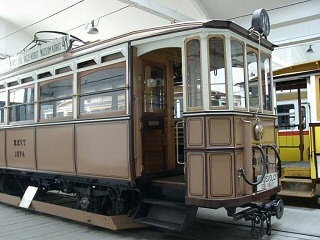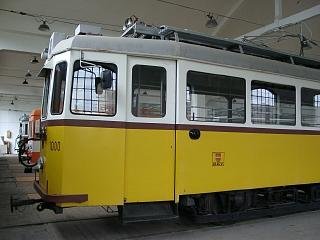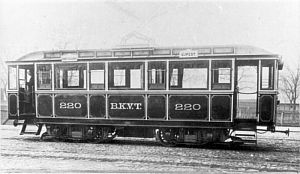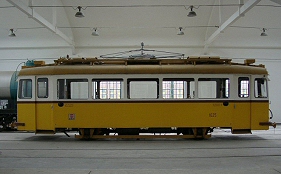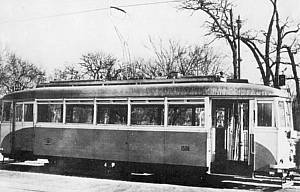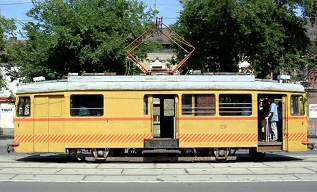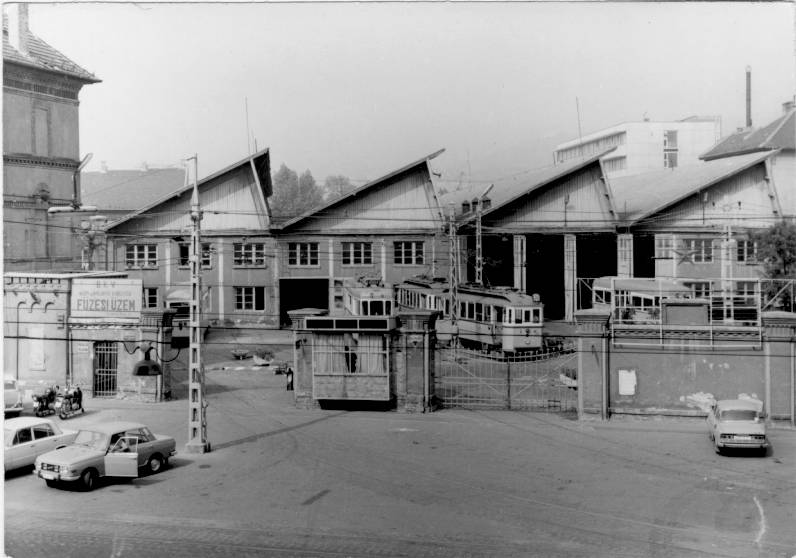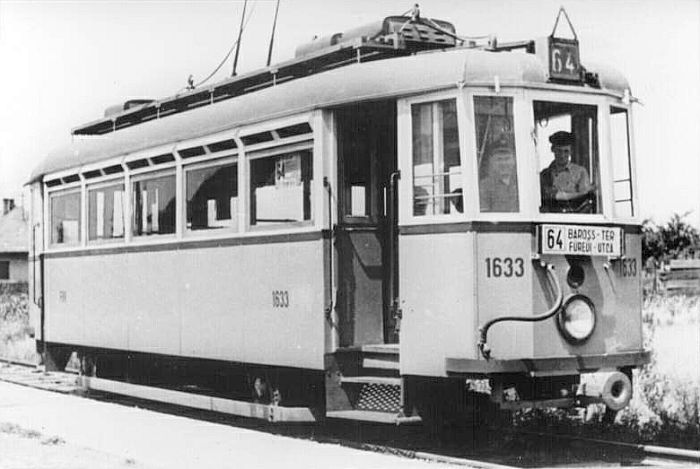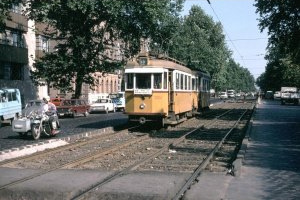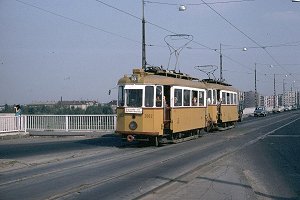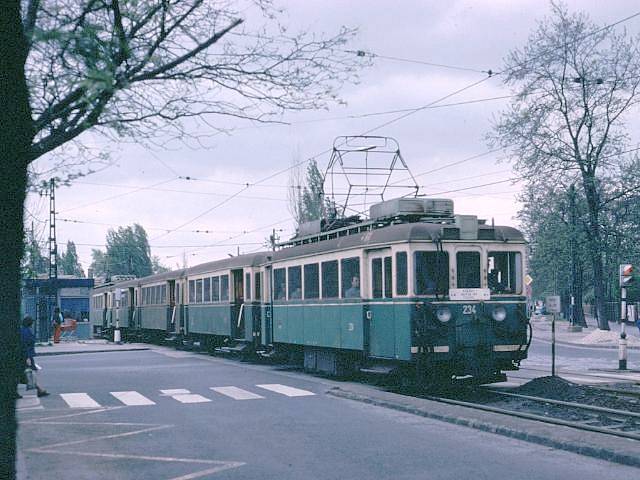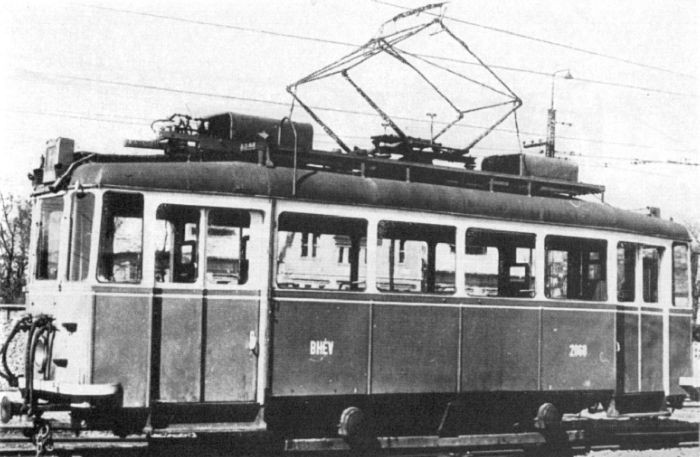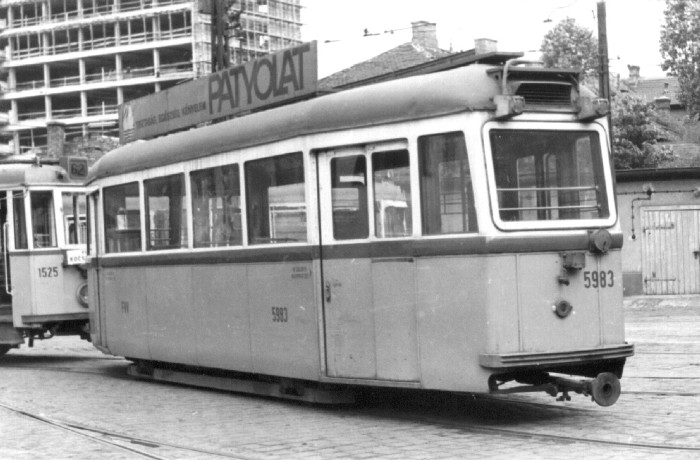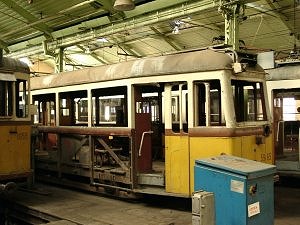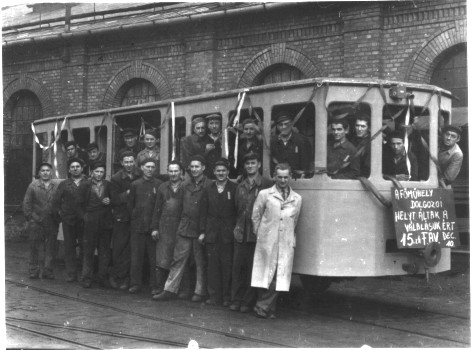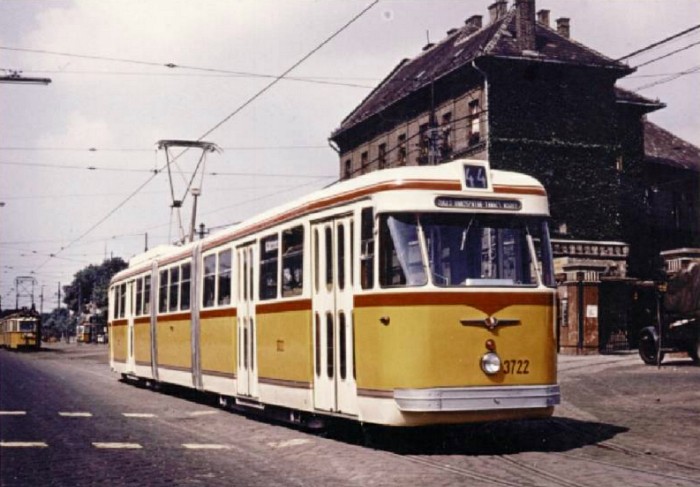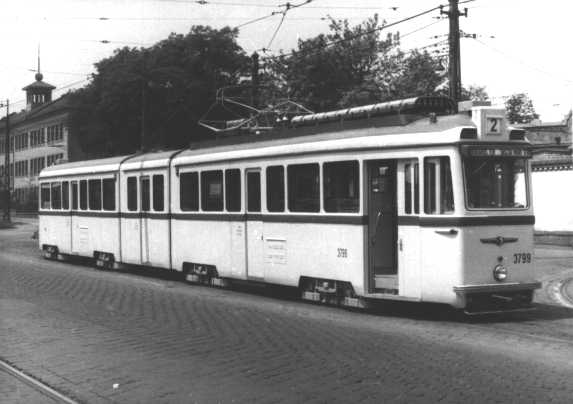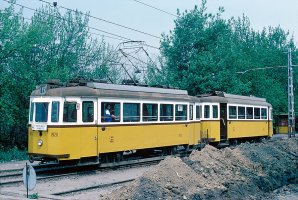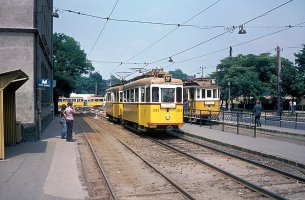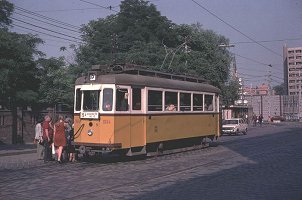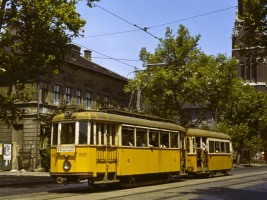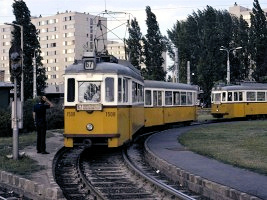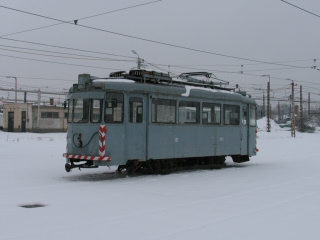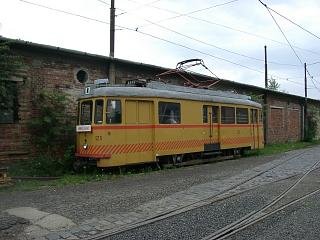budapest
other hungarian
close-up
lost rails
other countries
On my webpages - especially on those about Budapest's "lost" tram lines - you can see many old pictures of bulky four-wheel streetcars. They look quite alike, as the result of a standardised car-body. But beneath the same-looking surface, these trams were in fact rather different.
Would you believe that these two trams above are basically the same type?
Or that these can have anything in common?
Or that the trams on the pictures above depict the very same tramcar?
On this page, I would like to give you some basic information about the hungarian quivalent of East-Germany's "ReKo-Wagen" or West-Germany's "Aufbauwagen" - the replacement of old, wooden-frame car-bodies with steel-frame ones by the Füzesi Árpád Main Tramway Workshop of the Capital Tramways (FVV). I'll also introduce some of the workshop's later developments, like the Bengáli articulated trams.
Premise
The steel-frame era starts
The Füzesi steel-frame car bodies
Trailers
The Bengáli and other artics
Twin sets
Afterlife of the Füzesi steel-frame chassis
The end of the Füzesi workshop
This page is for informational causes, therfore some data and the phrasing might lack academic accuracy. It's not a thorough description of the history of a couple of hundred vehicles either, mainly because that would have been a tremendeous job - even to read, let alone to write :) If you're more into tables with exact dates and figures, I don't have them - some details of the modernisations/converts which this page is about, are still unclear to me. If you find any errors/mistakes, please let me know! I would also like to thank for the archive photos from villamosok.hu, from the collections of Zoltán Ádám Németh and Zsolt Levente Nagy, and to András Székács, Dénes Lajos Nagy, Tim Boric and Heinz Heider.
In the second decade of the 20th century, BKVT - one of the two large tram companies of Budapest - extended its tram depot in Kelenföld with new halls. The old halls were used as a workshop from then on, where they performed overhauls, major repairs and modifications on the company's vehicles. This function remained even after the tram companies were merged into BSzKRt: the Kelenföld workshop became the main tram workshop on the Buda side, while the now non-existing depot in Dózsa György út (then called Aréna út) became the main tram workshop on the Pest side.
The workshop was named after Árpád Füzesi - a foreman of the workshop who died during World War 2 - in 1948. Next year BSzKRt was dissolved, and the workshop became a municipally owned company, first called FVFKV, then FVFV, until being merged back to FVV. After the war the restoration of damaged rolling stock became the primary task, and also the final assembly of the 2-axle trailers built in Győr by MWG. Later, trailers 5975-5993 were built entirely here (in 1951/52). Originally the old halls of the Kelenföld tram depot became the workshop while the new ones were used as the remise, but later the workshop extended into the remise, too.
Most pre-WW2 trams and HÉV (suburban railway) cars of Budapest were built with wooden frameworks that took aging and overexertion badly. They also had insufficient rigidity during accidents, leading to casulties.
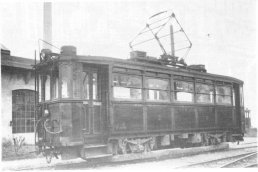
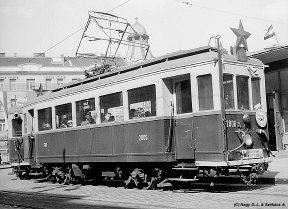
Photo to the left: villamosok.hu, photo to the
right: András Székács és Dénes Lajos
Nagy
Early experiments were undertaken on the South-Buda HÉV lines that used tram-like rolling stock - the type U (later M IV) and type E (later M V) motorcars were in fact 1000-volts versions of the BKVT type V (or better known as the 1000-series). The first of these cars were rebuilt in 1937/38 with a steel-frame bodywork, and later they even built entirely new vehicles at the Budafok depot. On the pictures above we see an original (wooden-frame) type U HÉV car, and a new, steel-frame car built instead of a wooden-frame car destroyed in an accident. There were also similar rebuilds in the main HÉV workshop in Cinkota, using prefabricated steel-frame bodies produced in Győr, and later Debrecen.
The design of the Füzesi steel-fram car body - in my humble opinion being much classier than the earlier, rather boxy rebuilds - was based on a yet wooden-frame rebuild of a type F1 tram in 1938. That rebuild was done by the Buda tram workshop, later known as the Füzesi workshop. The "new" type was known as the F1A, and was built - now with a steel-frame body - by the BSzKRt and MWG Győr in series during the war. Interestingly a batch of these cars could not receive its electric equipment because of the war, so they were put in usage as trailers - towed by their sister cars (see photo above). This odd situation ended around 1949, when all cars were fitted with motors. By the way, I think the look of this type was influenced by the type M trams and type N Stadtbahn cars of Vienna - at least they bear some resemblance.
The Füzesi steel-frame car bodies
The Füzesi workshop started its long series of overhauling trams with steel-frame bodies in 1955, starting with the F1 type:
The look of the cars was very similar to the F1A, but instead of the double-width doors on the end platforms, they used single-width doors, slowing down passenger flow. The lines of these cars was very edgy, width extensive usage of wood in the interior and window frames.
The time-line of conversions for Budapest can be "simplified down" to this:
| Year | Tram types (series) | HÉV types (series) |
| 1955 |
1600 | |
| 1956 | 1600, 2500, 2700 | M II, M V, P III |
| 1957 | 2500, 2700 + three 2800 cars damaged in the Revolution | M II, M V, P III |
| 1958 | 1000, 2500, 2700 | M I, M II, M V, P III, P X |
| 1959 | 1000, 2500, 2600, 2700 | M I, M II, M XI, P III, P XI |
| 1960 | 1000, 2500, 2600, 2700 | M III, P III, P XI |
| 1961 | 1000, 2600 | P III, P XI, P XX |
Rebuilds occured obviously not on a "one series in a row"-manner, but when an overhaul was due. And not all similar series were modernised: while the former BVVV series' 2500, 2600, 2700 received steel-frame car bodies, the 2800, 2900 and 3000 series had not (with the exception of 2827, 2844 and 2846, which were badly damaged in the 1956 Revolution) - despite all of them being very similar types. Some of the rebuilt cars later went to the provincial tram systems (Debrecen, Szeged, Szombathely, Pécs, Miskolc), and there were also some builds/rebuilds directly for these systems, so the conversion programme was not limited to Budapest.
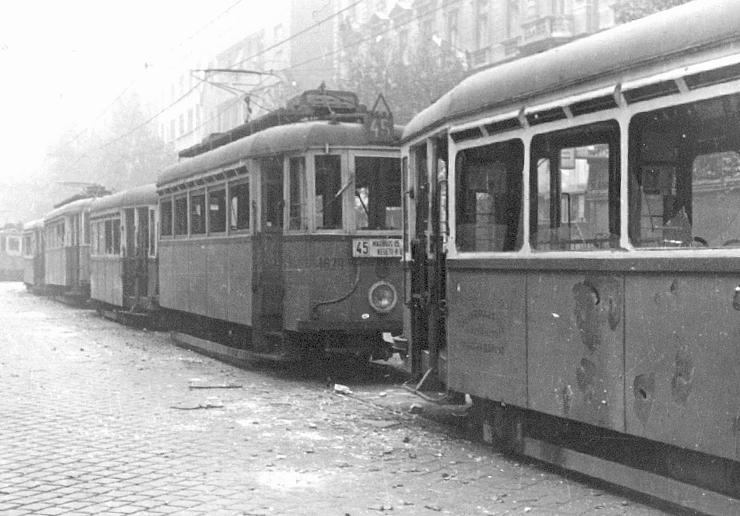
Photo: villamosok.hu
The first few batches of rebodied trams were already in use by the time of the 1956 Revolution, so on some photos depicting sceneries of urban warfare you can discover such vehicles - like number 1629 on the photo above, standing in a long row of immobile trams in Rákóczi út.

Photo: András
Székács és Dénes Lajos Nagy
Of course while details were tailored to the original vehicle being rebodied, the design also changed a bit from year to year. Earlier we've seen the edgy early version, later some bits got a bit rounded (like window frames, see above).
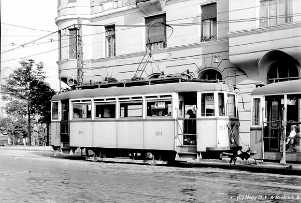
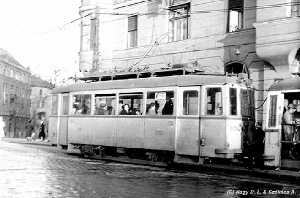
Photos: András
Székács és Dénes Lajos Nagy
Until now we have only seen what we tram fans like to call "the 5-window Füzesi" (after the number of windows on one side), but the shorter vehicles of BVVV were also rebuilt - they got to be the "4-window Füzesi". On the two pictures above you can nicely see some differences between different production batches: the car on the left has open platforms with folding bars, the one on the right has sliding doors. The one on the left has small blow-holes above the windows, the one on the right lacks them.
Later there were even more versions, for example cars received a central ventillation shaft inside the roof, which had two blow-holes on the side of the route number box above the windshield (in the style of the Stuka/UV). Also, after some time, open platforms gave way to closed platforms with sliding doors. The width of the shading sheets above the windshield also varied, not to speak about the changes in headlights, etc.
Starting from 1959, the Füzesi workshop took part in the modernisation of HÉV cars again, but with a body style that resembled the modernisations undertaken by the HÉV's Cinkota workshop - apart from a few exceptions, like the total rebuild of a damaged HÉV car:
Interestingly enough, latter rebuild showed that double-width doors could have worked, despite the long body's odd ratio to the small wheelbase!
If you're mixed up about what was turned into what, what was a tram and what was a HÉV, don't worry: it was really a mess! Some trams were rebodied into HÉV cars, but were later converted to tram twin sets, while there were HÉV cars which got turned into trams. This was possible in the first place because some HÉV lines operated with tram-like vehicles under tram-like conditions were in fact operated by the tram company. There were also cars that proliferated: for example M2035 and M2033 of the HÉV was rebodied, which basically meant that the electric and brake systems were put into a new vehicle. Then the remaining - empty - wooden-frame vehicles were retrofitted with electric and brake systems, and the now working trams were taken to Miskolc. A few years later they were rebodied there with steel-frame bodies produced by the Füzesi workshop, so out of the two wooden-frame HÉV cars emerged two HÉV cars and two trams - all four with steel-frame bodies! Of course this procedure gives a hint at how much of a "modernisation" this was - in some cases the term "built from scratch" might be more appropriate :)
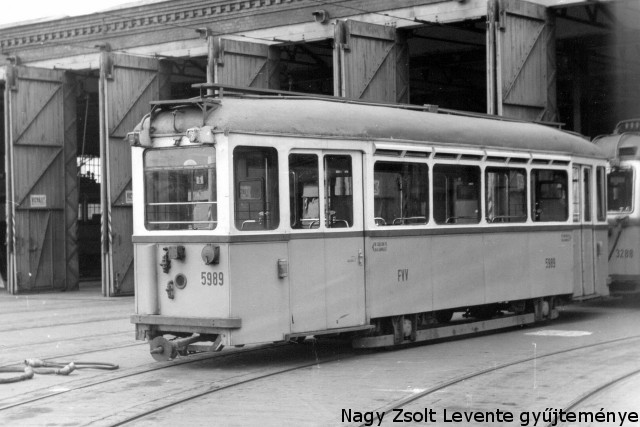
From the collection of Zsolt Levente Nagy
As mentioned earlier, the Füzesi workshop had already been engaged in the production of trailer cars. Later they were the ones to modify some of these trailers for usage between two UV motorcars. Even more later they also took part in replacing the folding bars on the open platforms with telescopic doors.
Two trailers (5965 and 5983) were so badly damaged during the 1956 Revolution, that they served as an experiment: they were rebuilt with UV parts ordered from Ganz-MÁVAG. At the end the experiment did not lead to more such cars, because retrofitting open-platformed trailers with telescopic doors proved to be more economic.
One of these two trailers was retained, it awaits renovation, then it should be displayed in a museum. It's a really strange creature, I must say :)
By the end of the 1950s the capacity of the original motorcars used on the shallow subway (Milleneum Subway Line) proved insufficient, so a batch of 2-axle driving trailers was built.
In 1961 the steel-frame modernisation programme was discontinued (overhauls of already converted vehicles continued though). After changes in the management, the workshop launched a seemingly ambitious project: the conversion of 1928 mid-entrance cars 3132+3133 into an articulated vehicle with a floating middle part. This was the birth of the "home-made articulated", or the "Bengáli", as it's known to some.
The project started badly: it turned out that the two mid-entrance cars were too worn for the conversion, so instead FVV has had the undercarriage built after the original plans in Debrecen. Completion and fitting of electric and other interior parts was done in Budapest. The first, unidirectional vehicle was unveiled in 1961, under the numbers 3720+3721. Yes - the front and the rear of the car both had fleet numbers (then it was changed to just 3720)!
In 1962 they introduced the bidirectional version, first numbered 3740, then 3722. Note that the middle part has no doors yet! Of course the construction was a failure from the start: a "two-rooms-and-a-bath" thing with awful riding comfort, low motorisation and weak framework. The last batch of unidirectional Bengális wasn't even accepted by the FVV - they were sent to the provincial tram systems right away. The type was withdrawn from Budapest quite soon, in 1979/80, when the Füzesi-style four-wheelers were still in operation. The bidirectional version didn't last much longer: it dissappeared from the streets of the capital in 1983.
Strangely the failure in Budapest did not mean the end for the Bengáli: the entire production was moved to Debrecen, and the type was produced until 1979. Imagine that! It was built longer than the Ganz articulated (the "industrial articulated" as it was called), and there was also more of them!
Turning everything into an articulated something became an obsession at the Füzesi workshop: in 1962 they built an articulated UV out of 3235 and 3258. The result was underpowered, and could not run in tight bends, so it was separated and converted back into two separate cars only four years later. Interestingly it wasn't yet the end of mistakes: number 3258 has had its two ends built back the other way around: what originally was the "A end" became the "B end" now.
Building twin sets was a regular thing in Budapest, in fact it was quite typical. It meant that two cars were sharing one electric and brake system, so that they were not usable when separated (in contrast to multiple units, where all car is a standalone vehicle on its own right).
Although the first series of twin set conversions have occured in the 1930s and 40s, a new programme started in the early 1960s, now affecting steel-frame tramcars. Starting in 1963, the 2700-series became the 2000-series of twins, the 1000ers and HÉV cars became the 1900ers (see above to the left), and later the 2500-series followed (above to the right).
Afterlife of the Füzesi steel-frame chassis
It seems the people in the workshop just did not know when to stop: after the all-round Bengáli they produced an all-edgy rebuild of number 1500 in 1963. Fortunately there were no such further rebuilds, they returned to the proven look.
Of course time did not stop: the Füzesi steel-frame design was altered constantly. On these two wonderful photos taken by Heinz Heider we see the same car in the early and in the late seventies. The design was slightly different at every overhaul cycle.
And here's another pair of pictures with the same theme. By the way, the 1500-series (type F1A) had had the most colorful stock: there were bidirectional, and there were unidirectional cars. Some had bow current collectors, others had pantographs. Some retained the double doors with folding bars and the blow-holes above the side windows, others had telescopic doors - some even automatically operated ones.
At the end, the almost-standard "Füzesi design" wasn't confined to the Füzesi workshop: the car to the left above was built from scratch by the Dózsa (Pest-side) workshop for Debrecen, while the very first F1A - number 1506, then 1520 - received a steel-frame modernisation in 1972 at the Fehér út central workshop of the BKV.
The end of the Füzesi workshop
The "reign" of the Füzesi workshop ended in the early seventies, when the Dózsa workshop was closed, and moved together with the UV workshop (located at Közvágóhíd) to the newly built central railway workshop of the BKV at Fehér út. For a long time the facility was still used for overhauls, but the capacity was reduced.
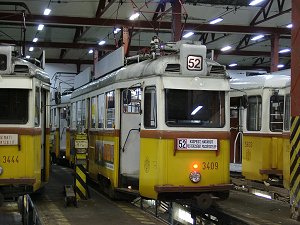
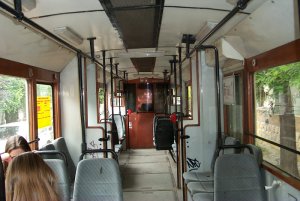
Interior shot (right): Ákos Baracsy
The last important contribution to Budapest's tram history was the modernised UV, the MUV, seen above. The buildings of the workshop are still standing (as of the end of 2009), but their usage is quite different, as most of its premises were sold in the 1990s. Fortunately remise Kelenföld still exits, so at least to some extent, these once "holy grounds" of Budapest tram history still see trams.
Archive hotos: NZA, Tim Boric, Heinz Heider, Székács
András, Nagy Dénes Lajos and Varga Ákos Endre + villamosok.hu
Source material: A 100 éves Budapesti villamosvasút története, 1987; A
főváros tömegközlekedésének másfél évszázada I-II-III
Back to the top Back to the main page
